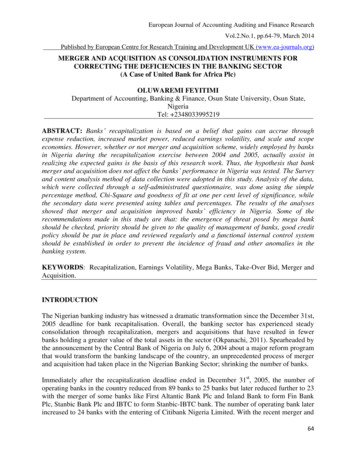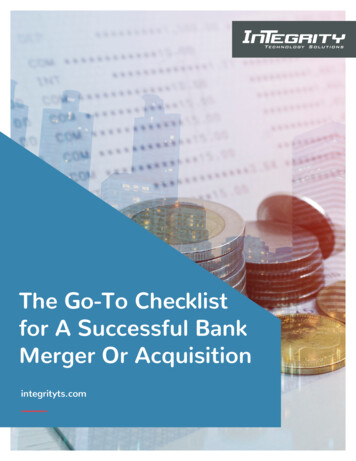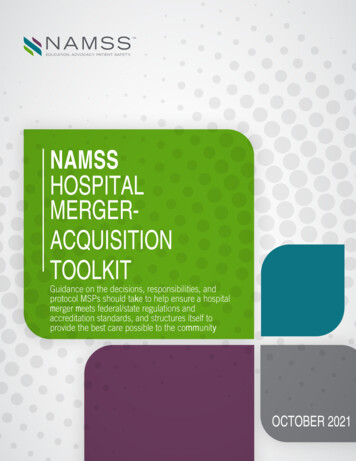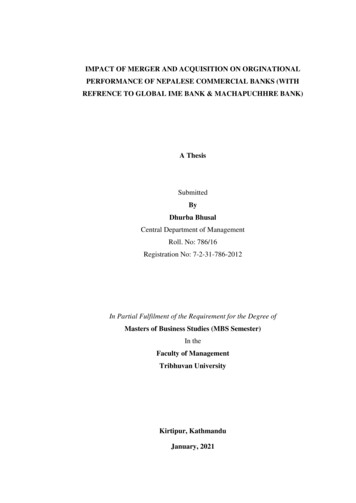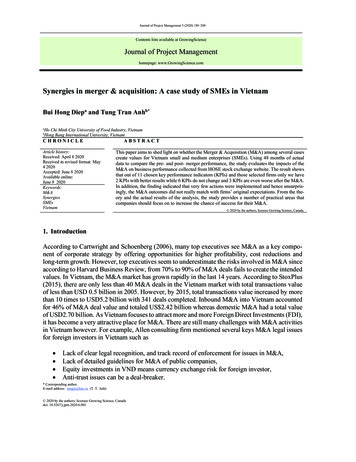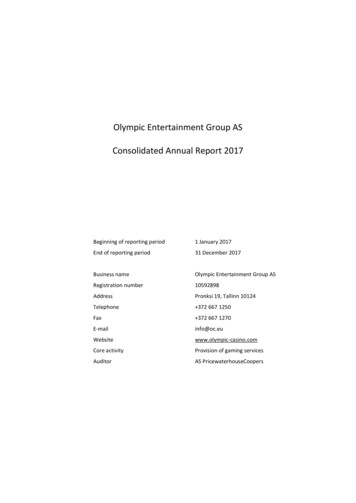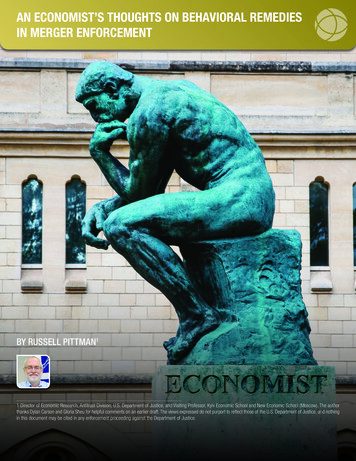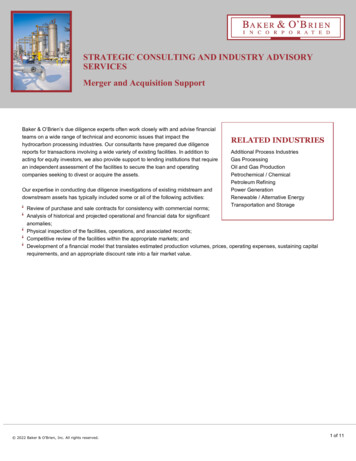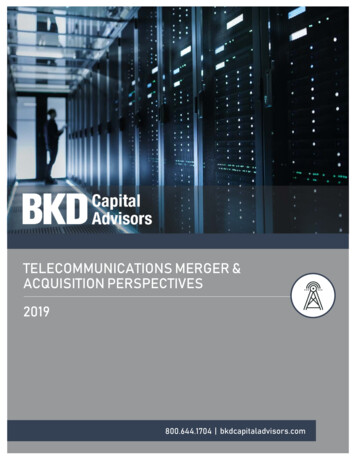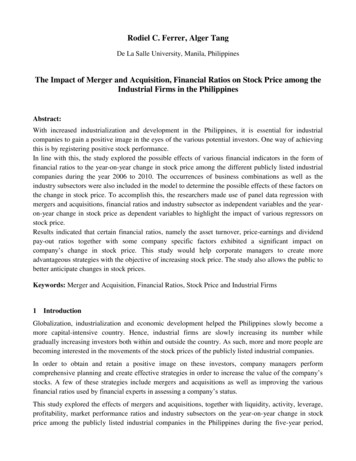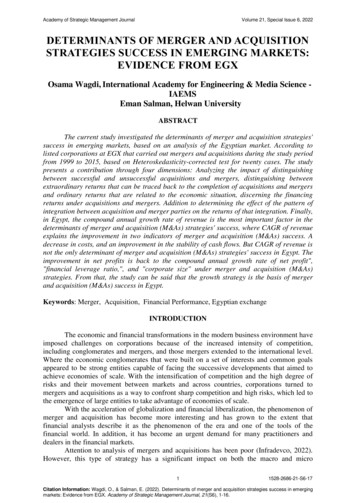
Transcription
Academy of Strategic Management JournalVolume 21, Special Issue 6, 2022DETERMINANTS OF MERGER AND ACQUISITIONSTRATEGIES SUCCESS IN EMERGING MARKETS:EVIDENCE FROM EGXOsama Wagdi, International Academy for Engineering & Media Science IAEMSEman Salman, Helwan UniversityABSTRACTThe current study investigated the determinants of merger and acquisition strategies'success in emerging markets, based on an analysis of the Egyptian market. According tolisted corporations at EGX that carried out mergers and acquisitions during the study periodfrom 1999 to 2015, based on Heteroskedasticity-corrected test for twenty cases. The studypresents a contribution through four dimensions: Analyzing the impact of distinguishingbetween successful and unsuccessful acquisitions and mergers, distinguishing betweenextraordinary returns that can be traced back to the completion of acquisitions and mergersand ordinary returns that are related to the economic situation, discerning the financingreturns under acquisitions and mergers. Addition to determining the effect of the pattern ofintegration between acquisition and merger parties on the returns of that integration. Finally,in Egypt, the compound annual growth rate of revenue is the most important factor in thedeterminants of merger and acquisition (M&As) strategies' success, where CAGR of revenueexplains the improvement in two indicators of merger and acquisition (M&As) success. Adecrease in costs, and an improvement in the stability of cash flows. But CAGR of revenue isnot the only determinant of merger and acquisition (M&As) strategies' success in Egypt. Theimprovement in net profits is back to the compound annual growth rate of net profit","financial leverage ratio,", and "corporate size" under merger and acquisition (M&As)strategies. From that, the study can be said that the growth strategy is the basis of mergerand acquisition (M&As) success in Egypt.Keywords: Merger, Acquisition, Financial Performance, Egyptian exchangeINTRODUCTIONThe economic and financial transformations in the modern business environment haveimposed challenges on corporations because of the increased intensity of competition,including conglomerates and mergers, and those mergers extended to the international level.Where the economic conglomerates that were built on a set of interests and common goalsappeared to be strong entities capable of facing the successive developments that aimed toachieve economies of scale. With the intensification of competition and the high degree ofrisks and their movement between markets and across countries, corporations turned tomergers and acquisitions as a way to confront sharp competition and high risks, which led tothe emergence of large entities to take advantage of economies of scale.With the acceleration of globalization and financial liberalization, the phenomenon ofmerger and acquisition has become more interesting and has grown to the extent thatfinancial analysts describe it as the phenomenon of the era and one of the tools of thefinancial world. In addition, it has become an urgent demand for many practitioners anddealers in the financial markets.Attention to analysis of mergers and acquisitions has been poor (Infradevco, 2022).However, this type of strategy has a significant impact on both the macro and micro11528-2686-21-S6-17Citation Information: Wagdi, O., & Salman, E. (2022). Determinants of merger and acquisition strategies success in emergingmarkets: Evidence from EGX. Academy of Strategic Management Journal, 21(S6), 1-16.
Academy of Strategic Management JournalVolume 21, Special Issue 6, 2022economy, so the study was investigated in mergers and acquisitions in Egypt as an emergingmarket, by examining the critical factors affecting the success of that strategy, in contrast toprevious studies that dealt with international markets (Gugler & Yurtoglu, 2004; Nguyen etal., 2012; Anagnostopoulos & Rizeq, 2021). It is this which helps both investors and topmanagement rationalise their decisions to be more rational in the light of determining thefactors governing the success of merger and acquisition operations.In Egypt, as opposed to the two preceding years, in which the number and value ofmergers and acquisitions (M&As) announced and completed increased year over year, 2021witnessed a decrease in these metrics. There were 76 deals involving Egyptian involvementthis year, including local and international deals. According to our own Enterprise M&ATracker, which we update throughout the year, the statistics in this piece are accurate. 38deals were completed in 2021, eight of them announced in 2020, and the rest announced andcompleted this year. There is a 40 percent completion rate on this year's anticipated deals,compared to a 56 percent completion rate in 2020 and an 80 percent completion rate in 2019.After all, out of the 76 deals announced in 2021, six of them were abandoned entirely. Some46 deals have been flagged as seeking regulatory clearance or appearing to be at some pointin the process of being completed. Top industries for mergers and acquisitions (M&As) in2021, by volume: Healthcare is at the top of the game, which has had 12 mergers andacquisitions (M&As) announced this year. The runners-up: energy (6), transport and logistics(6), and FinTech (4).Mergers and acquisitions (M&As) are not new in Egypt. This goes back to the depthsof the twentieth century. The development of the operations that took place in the stockmarket can be reviewed in the following figure.The current study presents a contribution through four dimensions: Analyzing theimpact of distinguishing between successful and unsuccessful acquisitions and mergers,distinguishing between extraordinary returns that can be traced back to the completion ofacquisitions and mergers and ordinary returns that are related to the economic situation,discerning between operating returns and financing returns in light of acquisitions andmergers and determining the effect of the pattern of integration between acquisition andmerger parties on the returns of that integration.THEORETICAL FRAMEWORK AND LITERATURE REVIEWCorporate strategy is the main driver of its investment and operational activities.Merger and acquisition strategies cannot be the result of randomness, but rather a long-termplanning process in which many models are used, including PESTEL analysis for hostcountry, Porter's Five Forces for industry, Boston Matrix for products (goods or services), Inaddition to the financial methods that work on the marginal change of benefits and risks atleast to create value for shareholders.Corporations need to take many elements when adopting a mergers and acquisitions(M&As) strategy. Figure (1) illustrates these elements.21528-2686-21-S6-17Citation Information: Wagdi, O., & Salman, E. (2022). Determinants of merger and acquisition strategies success in emergingmarkets: Evidence from EGX. Academy of Strategic Management Journal, 21(S6), 1-16.
Academy of Strategic Management JournalVolume 21, Special Issue 6, 2022FIGUREMERGERS AND ACQUISITIONS ELEMENTSThere is a large role for these variables in closing the merger and acquisition. Usually, the legalvariables are the variables that represent systematic risks. In Egypt; the key laws relevant to mergers andacquisitions (M&As) are the following:a. The Companies Law No. 159 for the year 1981 and its Executive Regulations, as amended (the“Companies Law”);b. The Capital Market Law No. 95 for the year 1992 and its Executive Regulations, as amended(“CML”) the Listing and Delisting Rules of the Egyptian Exchange and its executiveprocedures, as amended (“Listing Rules”); andc. The Egyptian Competition Law No.3 for the year 2005 and its Executive Regulations asamended (“Competition Law”) ; andd. The Investment Law No. 72 for the year 2017 and its Executive Regulations as amended(“Investment Law”)The key regulatory authorities relevant to mergers and acquisitions (M&As) are asfollows:a.b.c.d.The Financial Regulatory Authority (“FRA”);The Egyptian Exchange (“EGX”);The General Authority for Investment and Free Zones (“GAFI”); andThe Egyptian Competition Authority (“ECA”).Mergers and acquisitions (M&As) go through many steps, there are seven main stepsare1. Determining the key business goals from mergers and acquisitions (M&As); It is essential forthe corporation to know exactly why they are considering purchasing the target firm in order todevelop an effective merger and acquisition plan that will help them achieve their business goals(e.g., expanding product lines or gaining access to new markets).2. Determining the key criteria for mergers and acquisitions (M&As); Discovering essentialcriteria for identifying possible target firms (e.g., profit margins, geographic location, orcustomer base)31528-2686-21-S6-17Citation Information: Wagdi, O., & Salman, E. (2022). Determinants of merger and acquisition strategies success in emergingmarkets: Evidence from EGX. Academy of Strategic Management Journal, 21(S6), 1-16.
Academy of Strategic Management JournalVolume 21, Special Issue 6, 20223. Initial contact; it is made with one or more corporations that meet the mergers and acquisitions(M&As) search criteria and look to offer value; the goal of these discussions is to gatheradditional information and determine how receptive the target corporation is to a merger oracquisition.4. valuation For this purpose, a corporation requests that the target corporation be a merger oracquisition for considerable financial and nonfinancial information, that will allow it to furtherinvestigate and assess the target, both as a business on its own and as a viable merger oracquisition target.5. Negotiations; the corporations should be able to come up with an acceptable offer afterdeveloping multiple valuation models of the target corporation for mergers and acquisitions(M&As). After the initial proposal has been made, the two parties can discuss the details of thedeal in further depth.6. Determining the key criteria of the contract; Assuming negotiations are completed, a finalcontract for sale must be executed.7. Determining the key criteria of financing strategy; there are many options, including mix ofequity; loans and bonds for the long term versus bridge financing for the short term.Although the term “merger” is associated with acquisition,” there are significantdifferences between them. Acquisition may be a preferred strategy to enter the market in twoscenarios: a) if the industry in which the corporate operates is strong enough, and b) if theacquired corporate has strong protection against new entrants. In addition, the acquisitionmay be less risky compared to the development of new projects due to the presence ofacquired companies in the market for a long time, which reduces the phenomenon ofuncertainty. The acquisition can be viewed from several angles, as follows: In terms ofacceptance (Friendly acquisition or Hostile takeover) In terms of funding (Acquisitionthrough equity; debts; share swap) and in terms of the acquirer (External and Internal parties).A Leveraged Buyout (LBO) takes place when a small group of investors acquires thetarget company, and the acquisition is financed with the use of large debt or by selling someof its assets. The acquiring group generally plans to operate the acquiring company for anumber of years, with the aim of increasing its sales and profits. It is expected that theacquiring company will achieve high profits from the LBO. However, the risks are high dueto the acute use of debt (Johson, 1999). But a management buyout (MBO) is a special case ofleveraged buyout (LBO), where the members of the management are the ones who make theacquisition with reliance on debt to finance that process. (Kaplan & Strömberg 2009).There are many definitions of "merger"; it is a combination of two or more corporatesby aggregating shares together or transferring cash payments to the corporate subject to thetakeover or acquisition. (Johnson, 1999). In a broader sense, the acquisition of a corporate byanother corporate is a process of blending two corporates together. (Coyle, 2000). A processof agreement between two corporations to join together and pool their resources into a newbusiness entity, whereby the previous entities merge into a new corporate (StoneHouse, et al.,2000). A union of interests between two or more corporations, whereby a new entity appearsand the funds of the merged companies are transferred to the new corporate. (Wright et al.,2004).The study believes that it can be said that a merger or amalgamation is a process ofmixing two separate corporations to form one larger corporate, provided that one of themcontinues (the merging corporate) and the other (the merged corporate) vanishes, leaving itsassets and obligations to the merging corporate. These mergers are usually done through astock swap or liquid funds, which are paid to the target corporation, and shares are oftenexchanged, allowing the shareholders of the two corporations to participate in the risksinvolved in the transaction. A merger can occur through a friendly takeover of shares, withthe formation of one new corporate with new shares by mixing the names of the two mergedcorporates, or with the formation of a new brand.The main difference between a merger and an acquisition is the position of theshareholders in both cases. In the case of a merger, the shareholders of the two corporationsretain their shares in the new entity, or in the merging corporate, and thus becomeshareholders in the new corporate. In the case of acquisition, the acquiring corporate often41528-2686-21-S6-17Citation Information: Wagdi, O., & Salman, E. (2022). Determinants of merger and acquisition strategies success in emergingmarkets: Evidence from EGX. Academy of Strategic Management Journal, 21(S6), 1-16.
Academy of Strategic Management JournalVolume 21, Special Issue 6, 2022remains in existence and conducts its operations as usual, but the ownership of its sharespasses to the shareholders of the acquiring corporate. Either through cash payment or throughdebt bonds, the acquiring corporate, in this case, is able to control the acquiring corporate’sfixed assets, assets, and liabilities? In addition to that, the acquisition is either entirely bypurchasing all the assets of the acquired corporate or partially by owning part of the shares ofthat corporate. Often, when partial purchases are made, corporates look for shares acquired toenable the buying corporate to control the decisions of the board of directors or activelyparticipate in their issuance. In this case, they are called strategic shares.There is a difference between the mechanisms of financing mergers and acquisitions,as the merger is usually through the exchange of shares between the parties to the merger. Asfor acquisition, it takes one or more mechanisms through the following: borrowing; Bond;Bridge Financing and Venture capital. Usually, short-term financing mechanisms (bridgefinancing) are used as temporary financing for the acquisition process until the long-termfinancing mix is arranged.In general, mergers can be classified according to several criteria (Ross, et. al., 2011).According to the nature of the activities of the merged units( it includes: A horizontal merger,it takes place between two or more corporates working in the same type of activity or relatedactivities, such as the merger of banks and each other, or business banks with specialisedbanks. B - Vertical merger, it takes place between small corporates in different regions andlarge corporates in the main cities or capital on the other hand, or between a corporate andone of its suppliers or distributors or both. C - Mixed merging, it takes place between two ormore corporates engaged in dissimilar activities, such as the merger of a commercial bankand a specialized bank). 2- According to the standard of the relationship between the partiesto the merger process, (this includes: A- Optional merger, it is done with the approval ofboth the management of the merging corporate and the merged corporate. B - Obligatorymerger, it is a merger in which the management of the target corporate is opposed to thismerger or acquisition) 3- According to the merger result criterion (A distinction is madeaccording to this criterion between three basic methods: A- Merger with the disappearance ofthe legal status of the merged corporate or corporates. B- Buying all or part of the assets of anexisting corporate. C- Merger through control, while retaining the legal capacity of themerging corporate).The motives of the acquisition and merger processes are to increase the return to theshareholders and/or reduce the operational and financial risks. Positive interaction arises fromtwo sources: positive operational interaction (it aims to reduce the business risks likeachieving economies of scale, maximising the utilisation of intangible assets and theintegration of the activities of the two establishments upon merger), and market size andcompetitiveness. Increasing the effectiveness of complementary resources in the merging andmerged corporate) and positive financial interaction (it aims to reduce the financial risks towhich the corporate is exposed by improving financial liquidity, working capital, reducingthe imbalance of the financing structure, maximizing profits and the share of the distributedprofit, while limiting or reducing the merged corporate's financial risks).The study finds that the previous factors are one of the determinants of theequilibrium-required return by the shareholders of the acquiring corporate. Therefore, there isno benefit in the acquisition process if it is not of an additional return on the owners. Whichusually takes the form of maximizing profitability and maximizing the wealth of the owners(by maximizing the value of the share in the stock market, maximizing the fair value), whichrequires the acquired corporate to have the aforementioned characteristics in order tominimize the levels of risks to which the acquiring corporate is exposed. Whether these risksare operational or financial, even if these characteristics tend to be largely operational. Anumber of other factors affect the second type of risk.The degree of quality of financial and nonfinancial information affects the success ofmergers and acquisitions, as the acquiring corporates do not tend to choose corporates for51528-2686-21-S6-17Citation Information: Wagdi, O., & Salman, E. (2022). Determinants of merger and acquisition strategies success in emergingmarkets: Evidence from EGX. Academy of Strategic Management Journal, 21(S6), 1-16.
Academy of Strategic Management JournalVolume 21, Special Issue 6, 2022acquisition whose quality of a financial and nonfinancial information is low, and on thecontrary, if the acquired corporates enjoy high quality financial and nonfinancialinformation, this gives them a better negotiating position.The degree of similarity of that information plays a pivotal role in mergers andacquisitions. And financial and nonfinancial information is used in evaluation processes, asthe higher the degree of quality of financial and nonfinancial information, the greater thedegree of accuracy in estimating the value of the corporate acquired or merged, and degreeof quality of accounting information explained through its ability to reduce the degree ofuncertainty. (Biddle & Hilary 2010)In this regard, the importance of determining the trading margin on equity, whichresults from generating of additional returns for the acquisition process, in addition to thereturns resulting from operational operations, is highlighted.In order to determine the purpose of acquisitions, which is maximizing the wealth ofthe owners, the operating rate of return of the target entity must be compared with each of theweighted cost of capital for financing mergers and acquisitions (M&As), along with theinternal rate of return of the acquiring corporate. Finally, the rate of return required by the sof merged corporate.There are many studies concerning mergers and acquisitions, measuring their effectson financial performance and corporate value, such as (Wang 2003), who examined mergerrelated cost saving in the banking service. The study found a positive effect of the mergerprocess on banks' performance rates besides cost reduction due to economics of scale.Williams (2004) measured the impact of a recent merger between two aerospace corporationson the resulting organizational culture of the newly formed entity. The study showed apositive effect of the merger process on financial performance in the long run. The effect ofbank mergers on loan prices in the U.S. market was studied. The study found that mergedbanks have strong effects on operational cost reduction. (Said et al., 2008) tracked the impactof mergers and acquisitions on the efficiency of commercial banks in many countries. Itsfindings found a significant effect of the merger process on bank efficiency, such asprofitability, asset quality, liquidity, and return on capital. A study by Behr and Heid (2008)found no significant effect on merged banks' profitability. They conducted a study on thedeterminants of cross-border merger and acquisition performance of Chinese corporations;they found a positive relationship between the acquisition process and better financialperformance for Chinese corporations.The study found that the preceding factors are one of the determinants of theacquiring corporation's shareholders' equilibrium-required return. Therefore, there is nobenefit in the acquisition or merger process if it does not result in an additional return for theowners. Which usually takes the form of maximizing profitability and maximizing the wealthof the owners (by maximizing the value of the common share, maximizing the fair value),which requires the acquired or merger corporate to have the aforementioned characteristics inorder to minimize the levels of risk to which the acquiring corporate is exposed. Whetherthese risks are operational or financial, even if these characteristics tend to be largelyoperational. A number of other factors affect the second type of risk. Therefore, the successmeasures of merger and acquisition can be determined as follows:1.2.3.4.5.6.7.Marginal change in stock returns.Marginal change in stock systematic risk.Marginal change in stock unsystematic risk.Marginal change in stock total risk.Change in net profit margin.Change in cost of goods sales (COGS) margin.Improved stability cash flow.On other hand; for merger and acquisition strategies success an attractive candidatefor acquisition via a mergers and acquisitions (M&As) should possess some key attributes:1. The corporate must have a good position in its industry.2. The corporate has a profit history and reasonable expectations of growth.61528-2686-21-S6-17Citation Information: Wagdi, O., & Salman, E. (2022). Determinants of merger and acquisition strategies success in emergingmarkets: Evidence from EGX. Academy of Strategic Management Journal, 21(S6), 1-16.
Academy of Strategic Management JournalVolume 21, Special Issue 6, 20223. The corporate should have a relatively low level of debt and a high level of bank-able, assetthat can be used as loan collateral.4. The corporate has stable and predictable cash flow.STUDY METHODOLOGYExamination MethodologyThe study relied on the use of the unconventional measurement method to assess the effect of thereturns of mergers and acquisitions. Study considered the additional returns from mergers and acquisitions(M&As) processes, by excluding the returns resulting from non-mergers and acquisitions cases, which usuallyoccur in light of the pattern of economic activity in cases of boom and recession. That according to analyzingthe impact of distinguishing between successful and unsuccessful mergers and acquisitions (M&As).The study relied on regression analysis to estimate the relationship between the returns of corporatesand economic activity; according to equation No. (1); this relationship was estimated on the basis of economicgrowth rates since 1990CPJT aEG ,FIJ EGT EG ,FIJEquation No. (1)CPJT The Company (J)'S Performance in Time (T).aEG ,FIJThe Constant of the Relationship between Corporate Performance and Economic Growth.EGTEconomic Growth Rate in Time (T). EG ,FIJThe Sensitivity Coefficient of the Corporation's Performance to Economic Growth.The study relied on the average performance of corporates during the five yearsbefore and after the merger or acquisition process, in order to estimate the additional returnresulting from that mergers and acquisitions (M&As) process. The study distinguishedbetween extraordinary returns that can be traced back to the completion of acquisitions andmergers and ordinary performance that are related to the economic situation. Alpha is ameasure of the active performance of corporate based on the performance of that investmentcompared with an economic growth. J CPJT aEG ,FIJ EGT EG ,FIJ JEquation No. (2)The Alpha Coefficient of Average Extra Performance of Corporate (J) Without EconomicGrowth.CPJT The Actual Performance of Corporate (J) in Time (T).EGTEconomic Growth Rate in Time (T). EG , FIJThe Sensitivity Coefficient of the Corporation's Performance to Economic Growth.The study distinguishing financing returns under acquisitions and mergers accordingto equations no. 3, 4 and 5.FL FLDEDEEquation No. (3)Financial Leverage Ratio.Debt.Equity.71528-2686-21-S6-17Citation Information: Wagdi, O., & Salman, E. (2022). Determinants of merger and acquisition strategies success in emergingmarkets: Evidence from EGX. Academy of Strategic Management Journal, 21(S6), 1-16.
Academy of Strategic Management JournalVolume 21, Special Issue 6, 2022DFL ROA i (1 t ) DFLROAitEquation No. (4)Differential of Financial Leverage.Return on Assets Rate.Interest Rate on Debt.Tax Rate. D FLE ROA i (1 t ) E FLEROAitDEEquation No. (5)Financial Leverage EffectReturn on Assets Rate.Interest Rate on Debt.Tax Rate.Debt.Equity.The Financial leverage effect (FLE) may have positive or negative values based onarbitrage on owner's equity within debt, so that generating a positive or negative effect oncorporate performance.Data SourcesThe data sources can be viewed as follows:A.B.C.D.The Financial Regulatory Authority – Egypt (FRA)The Egyptian Exchange (EGX)Misr for Central Clearing, Depository and Registry (MCDR)Corporates ( from financial reports, which launched merger and acquisition)Study SampleThe current study includes twenty mergers and acquisitions deals as follows:Table 1THE STUDY SAMPLENo.12345678910151617181920CorporatePioneers Holding (current name: Aspire Capital Holdingfor Financial Investments)Orascom for Telecommunication, Media and TechnologyNational Development Bank (current name: )Sharm Dreams Holding for Tourism & HotlesCommercial International Bank -EgyptSharm Dreams Holding for Tourism & HotlesOrascom Construction IndustriesTalat Mostafa Group Holding (TMG Holding)Orascom Construction Industries (Orascom BuildingMaterials Holdingthat is member of OrascomConstruction Industries group)Telecom EgyptOriental WeaversMisr HotelsElectro Cable EgyptEgyptian Financial & IndustrialEl Nasr for Clothes (Kabo)Alexandria Spinning and itionMergerMergerMergerMergerMergerOct-06July 7Citation Information: Wagdi, O., & Salman, E. (2022). Determinants of merger and acquisition strategies success in emergingmarkets: Evidence from EGX. Academy of Strategic Management Journal, 21(S6), 1-16.
Academy of Strategic Management JournalVolume 21, Special Issue 6, 2022Study VariablesAlthough there are seven variables to measure the success of mergers andacquisitions, the study will be limited to "change in net profit & Hensher (2004); Rahman &Limmack (2004).However, the study excludes four measurement methods are Marginal change in"stock hold returns", "stock systematic risk", "stock unsystematic risk" and "stock total risk".This can be justified according to "capitalization", "market turnover", and institutionalcharacteristics of the Egyptian Exchange (EGX). The characteristics of the lower Corporatein sales were relied upon to estimate the independent variables and control versus the largestCorporate in sales for estimating the dependent variables. The study includes threeclassifications of variables as following.Study Independent VariablesThe Corporate's Position in Its Industry (CMS)The value of the variable can be estimated through the following equation CR Jt nCMS J 1i nMRt n n Equation No. (6)WhereThe average of market share for corporate (j)Total revenue for corporate (j) in year (t)Market size or total revenue for market in year (t)Compound Annual Growth Rate of Revenue (CAGRR)The value of the variable can be estimated through the following equationCAGRR J (t 0 t n ) t 0 t n RJ tn RJ t0 1 Equation No. (7)WhereCA GRR (t 0 t n ) Compound annual growth rate of revenue for corporate (j) from year (0) to year (t).R J tnRevenue for corporate (j) in year (n).R J t0Revenue for corporate (j) in base year.Pound Annual Growth Rate of Net Profit (CAGRP)The value of the variable can be estimated through the following equation.CAGRPJ (t 0 t n ) t 0 t n PJ tn PJ t 0 1 Equation No. (8)Where91528-2686-21-S6-17Citation Information: Wagdi, O., & Salman, E. (2022). Determinants of merger and acquisition strategies success in emergingmarkets: Evidence from EGX. Academy of Strategic Management Journal, 21(S6), 1-16.
Academy of Strategic Management JournalVolume 21, Special Issue 6, 2022CAGRP(t 0 t n ) Compo
Merger and acquisition strategies cannot be the result of randomness, but rather a long-term planning process in which many models are used, including PESTEL analysis for host country, Porter's Five Forces for industry, Boston Matrix for products (goods or services), In addition to the financial methods that work on the marginal change of .
